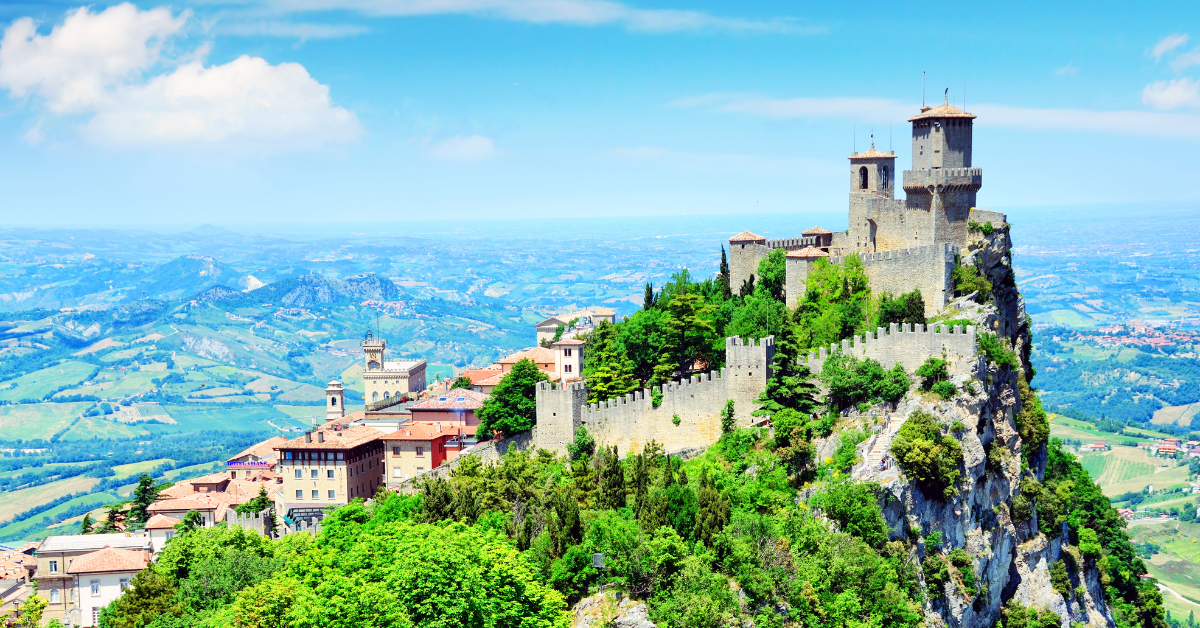The official kanji representation “聖馬力諾” (Sei-Baryaku) carries the spirit of faith, freedom, and enduring independence.
Despite its small size, San Marino has maintained its republican ideals for over 1,300 years, standing as a timeless symbol of peace and dignity in the modern world.
What “聖馬力諾” Means
The kanji name “聖馬力諾” (pronounced Seibaryaku) represents the Italian “San Marino.” The character “聖” (holy) signifies faith, while “馬力諾” reproduces the phonetic sound of “Marino.” Together, they express the idea of “Saint Marinus”, the founder of the nation. The name symbolizes religious reverence and independence.
| Item | Description |
|---|---|
| Japanese Name | Republic of San Marino |
| Kanji Representation | 聖馬力諾 |
| English Name | Republic of San Marino |
| Area | Approx. 61 km² |
| Government | Republic (World’s Oldest Republic) |
| Official Language | Italian |
This expression is more than a simple phonetic translation. It embodies San Marino’s spiritual foundation and its proud cultural identity.
History and Religious Background
San Marino traces its origins to the 4th century, when the Christian stonemason Saint Marinus fled persecution under the Roman Empire and founded a community on Mount Titano. Since then, this miracle of independence has endured for over 1,700 years without foreign domination.
The nation’s coat of arms bears the word “LIBERTAS” (Freedom), reflecting its founding philosophy. Religion plays a central yet gentle role — not in politics, but as the moral compass of its people.
| Era | Key Event | Significance |
|---|---|---|
| Around 301 AD | Founding by Saint Marinus | Establishment of freedom of faith |
| 13th Century | Establishment of a republic | Foundation of the world’s oldest republic |
| 1862 | Treaty of friendship with Italy | Symbol of peaceful diplomacy |
| 20th Century | Neutrality in world wars | Recognition as a peaceful nation |
San Marino thus represents “a small nation that stood firm in its beliefs,” standing as a model of resilience and conviction throughout history.
How Japanese People View San Marino
To many Japanese, San Marino evokes images of a small, quiet, and historically rich country. Its medieval old town atop Mount Titano is a UNESCO World Heritage Site, featuring cobblestone streets and fortress towers that seem frozen in time.
| Japanese Impression | Background or Reason |
|---|---|
| A small but proud country | The fifth smallest nation yet fiercely independent |
| Peaceful and safe | Political neutrality and strong public safety |
| Historic and beautiful | Medieval charm of Mount Titano’s old town |
| Motorsport heritage | Known for the San Marino Grand Prix (F1) |
| Friendly toward Japan | Cultural exchange and warm hospitality |
San Marino’s growing interest in Japanese culture, from anime exhibitions to traditional food festivals, has strengthened the emotional connection between the two nations. This shared respect for culture and harmony enhances its positive image among Japanese travelers.
Relations Between San Marino and Japan
Japan and San Marino established diplomatic relations in 1996. Since then, cooperation has deepened in the fields of culture, education, and tourism. As a country focused on tourism, San Marino welcomes visitors from Japan warmly.
| Field | Type of Exchange |
|---|---|
| Diplomacy | Official relations established in 1996 |
| Education | Japanese language courses at the University of San Marino |
| Tourism | Japanese-language guides and signage introduced |
| Culture | Film festivals and craft exhibitions held |
| Economy | Modest trade and tourism partnership |
Through these initiatives, San Marino has earned the reputation of being “the most Japan-friendly nation in Europe.” Mutual cultural respect continues to strengthen ties between the two countries.
The Charm of the World’s Fifth Smallest Country
San Marino’s charm lies in its “diversity within compactness.” Despite being roughly the size of Tokyo’s Shibuya Ward, it combines culture, nature, and history in perfect balance.
From the Three Towers of Mount Titano, visitors can gaze upon the Adriatic Sea — a breathtaking view that embodies the nation’s harmony between mountain and sea.
| Category | Description |
|---|---|
| Culture | Centuries-old republican traditions |
| Tourism | Scenic views from the Three Towers |
| Nature | Harmony between mountains and the sea |
| Lifestyle | High happiness and social stability |
| Economy | Steady management despite small scale |
San Marino is often called “a hidden European paradise of security and serenity.” It values not material wealth, but spiritual richness and human connection, making it one of the most livable places in Europe.
National Character and Cultural Values
San Marino’s people are known for being gentle, sincere, and proud. The country’s small scale fosters a tight-knit community spirit, where mutual trust and cooperation are deeply valued.
| Trait | Description |
|---|---|
| National Character | Honest, cooperative, and calm |
| Social Structure | Strong family and community ties |
| Education | Nearly 100% literacy rate |
| Religion | Catholic faith with open values |
| National Motto | Emphasis on freedom, peace, and sincerity |
This warm-hearted culture leaves a lasting impression on visitors, who often describe the country as “a place where kindness feels natural.”
Conclusion
The kanji name “聖馬力諾” embodies San Marino’s enduring values — faith, freedom, and dignity. It represents a small yet mighty republic that has preserved its identity through centuries of change.
For Japan, San Marino is still a lesser-known country, but one that reflects ideals deeply resonant with Japanese values: peace, respect, and harmony. Small in size yet great in spirit, San Marino reminds us that true wealth lies not in size or power, but in the strength of conviction and community.






